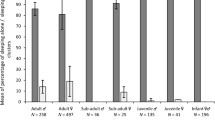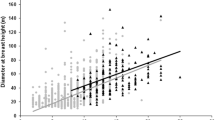Abstract
Huddling groups at sleeping sites, and allogrooming and proximity in the daytime during winter, were examined in a wild Japanese macaque (Macaca fuscata) troop on Kinkazan Island in the non-snowy district of northern Japan. All sleeping groups, defined as a cluster in which individuals huddle at sleeping sites, were formed on the ground. Their sizes tended to increase when the temperature was lower. The number of adults with mutual physical contact in sleeping groups increased when the size of sleeping groups increased. These results suggest that the physiological function of huddling is protection from low temperatures, and that macaques select the ground as sleeping sites to form large sized groups. Huddling was performed most frequently among kin dyads. Non-related dyads which appeared to be affiliative in the daytime also huddled frequently at sleeping sites. Even non-related dyads which showed affiliative behavior less frequently in the daytime exhibited huddling, at night, however, they did so less often than those of kin dyads and affiliated dyads. It appears that huddling at night by pairs that did not normally affiliate in the daytime was made possible by the increased tolerance of individuals responding to colder temperatures at night in winter. Furthermore, huddling, grooming, and proximity were exhibited at greater frequency between kin dyads, and between high-ranking males and specific females of kin groups, although the dyads of individuals older than 15 years often were involved only in huddling. These results suggest that two types of social bonds exist at sleeping sites in winter. One is the social bond common to both the daytime and nighttime, the other is peculiar to nighttime. Consequently, the social function of huddling is that, troop integration might increase at sleeping sites in winter as close social relationships among adults are extended more widely than those in daytime.
Similar content being viewed by others
References
Altmann, J. 1980.Baboon Mothers and Infants. Harvard Univ. Press, Cambridge, Massachusetts.
Anderson, J. R. 1984. Ethology and ecology of sleep in monkeys and apes. In:Advances in the Study of Behavior, Vol. 14,Lehrman,Daniel S. (ed.), Academic Press, New York, pp. 165–229.
Anderson, J. R.;McGrew, W. C. 1984. Guinea baboon (Papio papio) at a sleeping site.Amer. J. Primatol., 6: 1–14.
Ashizawa, S. 1977. Japanese monkeys in the Shimokita Peninsula.The Nihonzaru, 3: 11–22. (in Japanese)
Dunbar, R. I. M.;Nathan, M. F. 1972. Social organization of the Guinea baboon,Papio papio.Folia Primatol., 17: 321–334.
Gartlan, J. S.;Brain, C. K. 1968. Ecology and social variability inCercopithecus aethiops andCercopithecus mitis. In:Primates: Studies in Adaptation and Variability,Jay,P. C. (ed.), Holt, Rinehart & Winston, New York, pp. 253–292.
Gautier-Hion, A. 1971. L'Ecologie du talapoin du Gabon.Terre et la Vie, 25: 427–490.
Izawa, K. 1983. The ecological study of wild Japanese monkeys living in Kinkazan Island, Miyagi Prefecture: a preliminary report.Bull. Miyagi Univ. Educ., 18: 24–46. (in Japanese with English summary)
Izawa, K. 1992. A brief history of the ecological studies on the Japanese monkeys in Kinkazan.Miyagiken no Nihonzaru, 5: 1–2. (in Japanese)
Maruhashi, T. 1979. Natural life of the Yakuzaru (Macaca fuscata yakui): group movement and subgrouping.Monkey, 168: 6–15. (in Japanese)
Mori, A. 1979. Sexual difference in the tendencies to gather in night aggregations and grouping in the daytime in Japanese monkeys of the Koshima troop. In:The Differences of the Role of Sex in the Societies of Japanese Monkeys in Different Regional Population, Primate Research Institute, Kyoto Univ., Inuyama, Japan, pp. 41–49. (in Japanese)
Nakagawa, N. 1989a. Feeding strategies of Japanese monkeys against deterioration of habitat quality.Primates, 30: 1–16.
Nakagawa, N. 1989b. Bioenergetics of Japanese monkeys (Macaca fuscata) on Kinkazan Island during winter.Primates, 30: 441–460.
Napier, J. R.;Napier, P. H. 1985.The Natural History of the Primates. British Museum (Natural History) and Cambridge Univ. Press, Cambridge.
Sato, S. 1988. Monkeys of Kinkazan A-troop.Miyagiken no Nihonzaru, 3: 6–29. (in Japanese)
Vessey, S. H. 1973. Night observation of free-ranging rhesus monkeys.Amer. J. Phys. Anthropol., 38: 613–620.
Wada, K. 1964. Some observations on the life of monkeys in a snowy district of Japan.Physiol. Ecol., 12 (1, 2): 151–174. (in Japanese with English summary)
Wada, K.;Ichiki, Y. 1980. Seasonal habitat utilization of the Japanese monkeys in the Shiga Heights. In:Cold Adaptation of Japanese Monkeys, Primate Research Institute, Kyoto Univ., Inuyama, Japan, pp. 5–23. (in Japanese)
Wada, K.;Tokida, E. 1985. Sleeping site cluster of Japanese monkeys in Shiga A1 troop: about inter-individual relationships. In:The Studies of Spatial Distribution of the Japanese Monkey Troops in Shiga Heights, Primate Research Institute, Kyoto Univ., Inuyama, Japan, pp. 2–10. (in Japanese)
Author information
Authors and Affiliations
About this article
Cite this article
Takahashi, H. Huddling relationships in night sleeping groups among wild Japanese macaques in Kinkazan Island during winter. Primates 38, 57–68 (1997). https://doi.org/10.1007/BF02385922
Received:
Accepted:
Issue Date:
DOI: https://doi.org/10.1007/BF02385922




